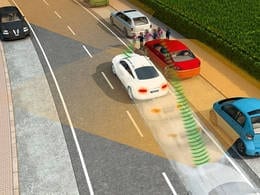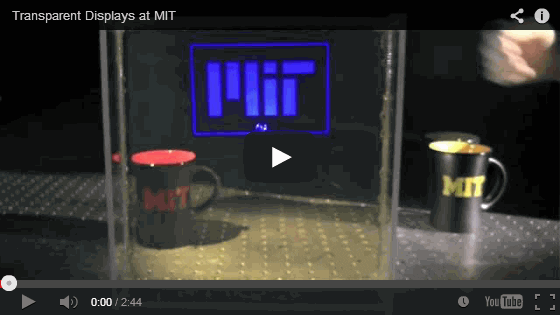
Researchers at the Technische Universitaet Muenchen (TUM) have developed a technique that enables driver assistance systems in cars to pinpoint pedestrians and cyclists – even while they are hidden from view.
To this end, pedestrian’s and cyclist’s cell phones could soon serve as transponders. On-board positioning systems would then compute the projected trajectory of the transponders and initiate an emergency braking sequence in case a pedestrian or cyclist moves into the path of a car.
A car drives at 30 km/h through a residential area. Vehicles are parked on the right side of the road. All of a sudden someone appears from behind a large trailer. The car comes to a sudden halt just in front of the pedestrian. Had the vehicle’s on-board positioning system not intervened, the car would have hit the pedestrian.
The pedestrian in this test was carrying a so-called transponder. A transponder is a radio transmitter and receiver that responds to specific signals. In this case, the approaching vehicle’s positioning system sends the signal. The position of the pedestrian is accurately determined by measuring his or her trajectory and distance from the vehicle.
In the context of the “cooperative transponder” research project, Ko-TAG, Professor Erwin Biebl and his team at the TU Muenchen have developed a completely new approach to distance measurement. The distance to an object can be determined to an accuracy of a few centimeters within just a few microseconds (millionths of a second). The on-board positioning system achieves this by sending a unique series of codes to a transponder. The transponder, in turn, modifies the code sequence and returns it in a very precise temporal pattern.
Safety and acceptance through precise distance measurement
Warning the driver or initiating an emergency braking sequence must generally happen before the pedestrian steps into the street. At the same time, the probability of false alarms must be kept extremely low if drivers are to deem the system effective and use it. An excellent movement prediction is thus indispensible.
In the context of their research, the scientists were able to reduce the measurement errors to a few picoseconds (billionths of a second). “With this, we achieved an accuracy in distance measurement of a few centimeters. Together with the unique code-based process, this is the explanation for the exceptional performance and an important unique selling point of our system,” says Professor Biebl.
Locating behind obstacles hitherto impossible
What makes this “cooperative sensor technology,” as it is referred to at Ko-TAG, so unique is that it can pinpoint vulnerable road users like pedestrians and cyclists even when they are obstructed from view. Furthermore, they can be uniquely identified as such and their movement patterns can be predicted by the cooperative sensor technology. This is not possible in current driver assistance systems.
The small transmitters can be integrated in clothing or school bags. However, cell phones could also serve as transponders in the future since the majority of people carry a cell phone with them most of the time anyway. Only minor hardware modifications would be required. One major cell phone manufacturer has already expressed interest in the system.
The Latest on: Driver assistance systems
[google_news title=”” keyword=”Driver assistance systems” num_posts=”10″ blurb_length=”0″ show_thumb=”left”]
via Google News
The Latest on: Driver assistance systems
- NHTSA Found Tesla’s driver assist features linked to hundreds of accidentson April 26, 2024 at 1:39 pm
In March 2023, tragedy struck when a North Carolina student was critically injured by a Tesla Model Y operating on Autopilot.
- Tesla driver said he was using Autopilot when he fatally hit a motorcycliston April 26, 2024 at 11:40 am
Incidents like the Washington crash have raised concerns about the effectiveness of Tesla's December recall.
- NHTSA concludes Tesla Autopilot investigation after linking the system to 14 deathson April 26, 2024 at 9:19 am
The National Highway Traffic Safety Administration (NHTSA) has concluded an investigation into Tesla’s Autopilot driver assistance system after reviewing hundreds of crashes, including 13 fatal ...
- 1 dead after water rescue in South-Central El Pasoon April 26, 2024 at 7:19 am
One person has died after a water rescue Friday morning, April 26 in South-Central El Paso, according to a spokesperson with the El Paso Fire Department. The spokesperson says the water rescue was ...
- Ellen DeGeneres to Address ‘Second Time I’ve Been Kicked Out of Show Business’ in Netflix Special (Report)on April 26, 2024 at 6:44 am
Ellen DeGeneres is readying a Netflix special about her alleged showbiz exile. According to Rolling Stone, DeGeneres kicked off Ellen’s Last Stand… Up Tour Wednesday by acknowledging that her public ...
- Tesla Driver Charged With Killing Motorcyclist After Turning on Autopilot and Browsing His Phoneon April 23, 2024 at 11:35 am
An accident involving a Tesla and a motorcycle on July 24, 2022 near Draper, Utah. Image: Utah Department of Public Safety A 28-year-old motorcyclist died in Washington State on Friday afternoon ...
- Linux can finally run your car’s safety systems and driver-assistance featureson April 23, 2024 at 7:43 am
There's a new Linux distro on the scene today, and it's a bit specialized. Its development was led by the automotive electronics supplier Elektrobit, and it's the first open source OS that complies ...
- Automotive ADAS (Advanced Driver Assistance System) Market worth US$ 2,11,710.80 million by 2034on April 22, 2024 at 10:25 pm
The global automotive ADAS (Advanced Driver Assistance System) market value is expected to rise from US$ 64,047.75 million in 2024 to US$ 2,11,710.80 million by 2034. This estimated growth is expected ...
- Senate Democrats urge crackdown on autonomous vehicles and driver assiston April 18, 2024 at 6:00 am
Two prominent Senate Democrats are calling for increased scrutiny of autonomous vehicles and advanced driver-assist systems (ADAS) like Tesla’s Autopilot, arguing that the unimpeded flow of highly ...
- Ford’s BlueCruise hands-free driver assist under investigation after two fatal crasheson April 15, 2024 at 11:33 am
The National Transportation Safety Board is investigating two fatal crashes involving Ford Mach-Es crashing into stationary vehicles, where three people have died.
via Bing News









